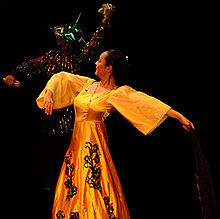Suku Kapampangan
| Jumlah populasi | |||||||||
|---|---|---|---|---|---|---|---|---|---|
| 2.89 juta (3.3%populasi Filipina) | |||||||||
| Daerah dengan populasi signifikan | |||||||||
(Pampanga, Tarlac, Bataan, Bulacan, Nueva Ecija, Zambales, Metro Manila) | |||||||||
| Bahasa | |||||||||
| Bahasa Kapampangan, Bahasa Tagalog), Bahasa Inggris | |||||||||
| Agama | |||||||||
| Mayoritas Katolik Roma, minoritas Ariya dan Aglipayan | |||||||||
| Kelompok etnik terkait | |||||||||
| Orang Filipina (Tagalog, Sambal, Ilokano, Pangasinan, Bikolano, suku bangsa lain di Filipina.) | |||||||||


Suku Kapampangan atau Pampango adalah salah satu suku bangsa di Filipina. Mereka membentuk populasi lebih dari 2 juta jiwa di Filipina. Kapampangan merupakan suku bangsa terbesar keenam di negara itu.
Bacaan tambahan[sunting | sunting sumber]
Wikimedia Commons memiliki media mengenai Kapampangan people.
- Bunford, Stephen R., The Royal House of Brunei, Unpublished manuscript
- Larkin, John A. 1972. The Pampangans: Colonial Society in a Philippine Province. 1993 Philippine Edition. Quezon City: New Day Publishers.
- Mallat, Jean, Les Philippines: Histoire, Geographie, Moeurs, Agriculture, Idustrie, Commerce des colonies Espagnoles dans l'Océanie, Paris: Arthus Bertrand, Libraire de la Société de Géographie, 1846
- Miyamoto, Kazuo. Vikings of the Far East. New York: Vantage Press, 1975. pp88–89
- Morga, Antonio de, Sucesos de las Islas Filipinas, obra publicada en Méjico el año de 1609 nuevamente sacada a luz y anotada por José Rizal y precedida de un prólogo del Prof. Fernando Blumentritt, Impresión al offset de la Edición Anotada por Rizal, Paris 1890. Manila: Historico Nacional, 1991
- Pires, Tomé, A suma oriental de Tomé Pires e o livro de Francisco Rodriguez: Leitura e notas de Armando Cortesão [1512 - 1515], translated and edited by Armando Cortesao, Cambridge: Hakluyt Society, 1944.
- Santiago, Luciano P.R., Laying the Foundations: Kapampangan Pioneers in the Philippine Church [1592-2001], Angeles City: Juan D. Nepomuceno Center for Kapampangan Studies, Holy Angel University Press, 20012
- Santiago, Luciano P.R., The Houses of Lakandula, Matanda, and Soliman [1571-1898]: Genealogy and Group Identity, Philippine Quarterly of Culture and Society 18 [1990]
- Scott, William Henry, Barangay: Sixteenth-Century Philippine Culture and Society, Quezon City: Ateneo de Manila University Press, 1994
- Scott, William Henry, Prehispanic Source Materials for the Study of Philippine History, Quezon City: New Day Publishers, 1984
- Tayag, Katoks (Renato). 1985. "The Vanishing Pampango Nation", Recollections and Digressions. Escolta, Manila: Philnabank Club c/o Philippine National Bank.
- Hipolito, Jose R. " History of Cabiao ". Kabyawan Books. 2010
- Wang Teh-Ming, Sino-Suluan Historical Relations in Ancient Texts: A dissertation submitted to the graduate program of the College of Social Sciences and Philosophy, University of the Philippines, 1989, Diliman, Quezon City.
- Johnny Mina, Moses Esteban, Frederick Manzano, and Lawrence Capiz, Research Paper Topic "Kapampangan Translation and Cultures". University of Baguio, 2001.
- Andro Camiling's Biographies of Famous Kapampangan Diarsipkan 2009-03-12 di Wayback Machine.
- While Pampanga is known as the Culinary Capital of the Philippines, there are more to the province than just food. Pampanga is a home to a hodgepodge of natural and man-made tourist destinations. In fact, every city or municipality in Pampanga Diarsipkan 2015-10-11 di Wayback Machine. boasts of its distinct destinations and observances.




